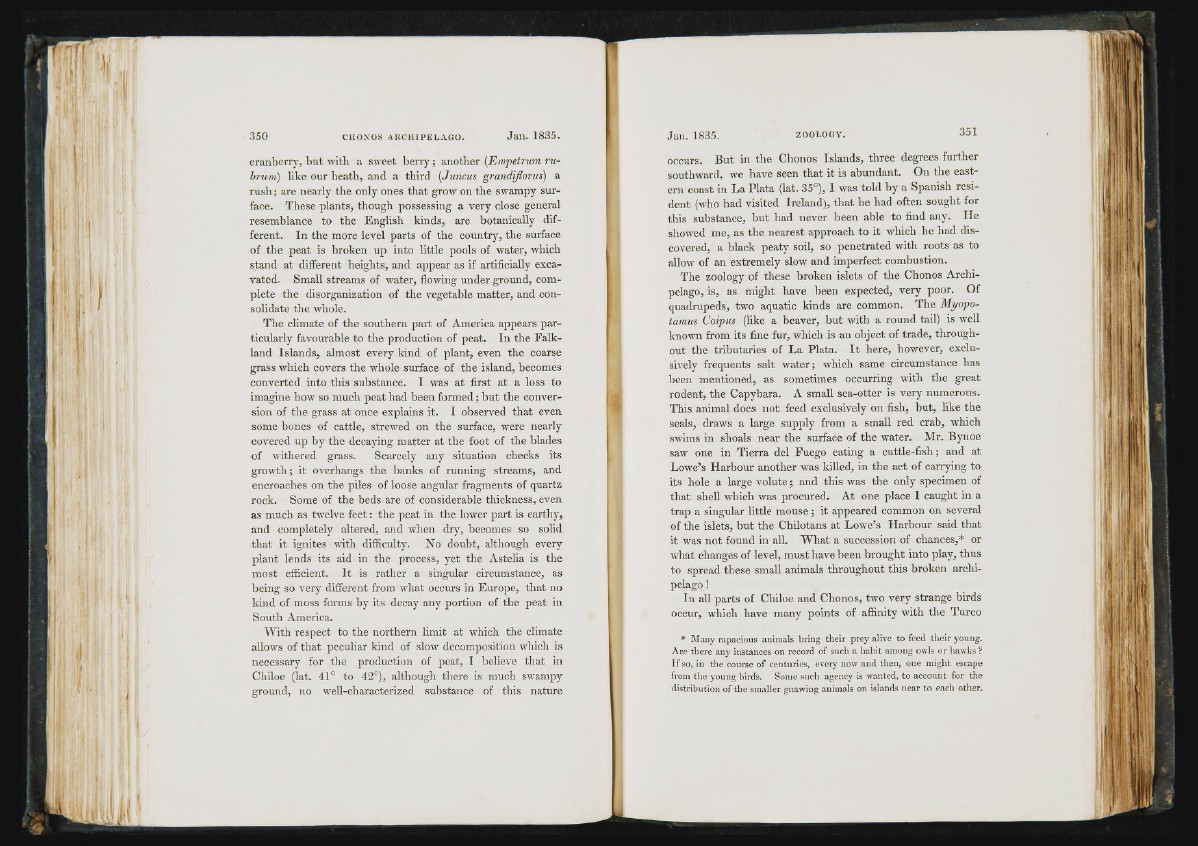
ftir!
!' iiJi
u r i
'M
I ! ) •
cranberry, but with a sweet berry; another [Empetrim ru-
brum) like our heath, and a third (Juncus grandijlorus) a
rush; are nearly the only ones that grow on the swampy surface.
These plants, though possessing a very close general
resemblance to the English kinds, are botanically different.
In the more level parts of the country, the surface
of the peat is broken up into little pools of water, which
stand at different heights, and appear as if artificially excavated.
Small streams of water, flowing under ground, complete
the disorganization of the vegetable matter, and consolidate
the whole.
The climate of the southern part of America appears particularly
favourable to the production of peat. In the Falkland
Islands, almost every kind of plant, even the coarse
grass which covers the whole surface of the island, becomes
converted into this substance. I was at first at a loss to
imagine how so much peat had been formed; but the conversion
of the grass at once explains it. I observed that even
some bones of cattle, strewed on the surface, were nearly
covered up by the decaying matter at the foot of the blades
of withered grass. Scarcely any situation checks its
growth; it overhangs the banks of running streams, and
encroaches on the piles of loose angular fragments of quartz
rock. Some of the beds are of considerable thickness, even
as much as twelve fe e t: the peat in the lower part is earthy,
and completely altered, and when dry, becomes so solid
that it ignites with difficulty. No doubt, although every
plant lends its aid in the process, yet the Astelia is the
most efficient. It is rather a singular circumstance, as
being so very different from what occurs in Europe, that no
kind of moss forms by its decay any portion of the peat in
South America.
AA’ith respect to the northern limit at which the climate
allows of that peculiar kind of slow decomposition which is
necessary for the production of peat, 1 believe that in
Chiloe (lat. 41° to 42°), although there is much swampy
ground, no well-characterized .substance of this nature
occurs. But in the Chonos Islands, three degrees further
southward, we have seen that it is abundant. On the eastern
coast in La Plata (lat. 35°), I was told by a Spanish resident
(who had visited Ireland), that he had often sought for
this substance, but had never been able to find any. He
showed me, as the nearest approach to it which he had discovered,
a black peaty soil, so penetrated with roots as to
allow of an extremely slow and imperfect combustion.
The zoology of these broken islets of the Chonos Archipelago,
is, as might have been expected, very poor. Of
quadrupeds, two aquatic kinds are common. The Myopo-
tamus Coipus (like a beaver, but with a round tail) is well
known from its fine fur, which is an object of trade, throughout
the tributaries of La Plata. I t here, however, exclusively
frequents salt water; which same circumstance has
been mentioned, as sometimes occurring with the great
rodent, the Capybara. A small sea-otter is very numerous.
This animal does not feed exclusively on fish, but, like the
seals, draws a large supply from a small red crab, which
swims in shoals near the surface of the water. Mr. Bynoe
saw one in Tierra del Fuego eating a cuttle-fish; and at
Lowe’s Harbour another was killed, in the act of carrying to
its hole a large volute; and this was the only specimen of
that shell which was procured. At one place I caught in a
trap a singular little mouse; it appeared common on several
of the islets, but the Chilotans at Lowe’s Harbour said that
it was not found in all. What a succession of chances,* or
what changes of level, must have been brought into play, thus
to spread these small animals throughout this broken archipelago
!
In all parts of Chiloe and Chonos, two very strange birds
occur, which have many points of affinity with the Turco
* M a n y rap a c io u s a n im a ls b r in g th e i r p r e y a liv e to fe e d th e i r y o u n g .
A r e th e r e a n y in s ta n c e s o n r e c o rd o f su c h a h a b it am o n g owls o r h aw k s ?
I f so, in th e c o u rse o f c e n tu rie s , e v e ry n ow a n d th e n , o n e m ig h t e sca p e
from th e y o u n g b ird s . S om e su c h a g e n cy is w a n te d , to a c c o u n t fo r th e
d is tr ib u tio n o f th e sm a lle r g n aw in g a n im a ls o n islan d s n e a r to e a ch o th e r .
I f